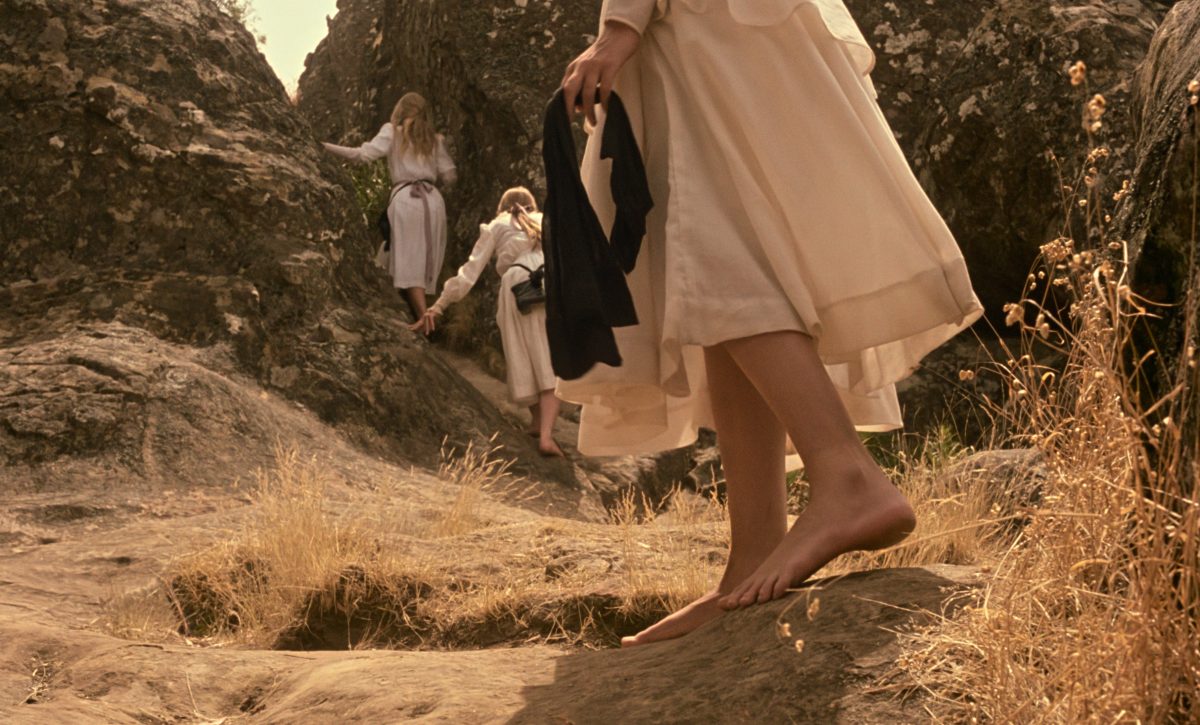
The following notes on Picnic at Hanging Rock were written by Ashton Leach, PhD candidate in the Department of Communication Arts at UW – Madison. A new 4K restoration of Picnic at Hanging Rock will screen in honor of the movie’s 50th anniversary on Friday, November 7. The screening begins at 7 p.m. at 4070 Vilas Hall, 821 University Ave. Admission is free!
By Ashton Leach
Peter Weir’s Picnic at Hanging Rock (1975) arrived at a moment when Australian cinema was finding itself again. After decades of relative quiet, the 1970s ushered in the Australian New Wave — a period of self-recognition and national exploration, when filmmakers began to question what it meant to make an “Australian film.” Produced on a modest budget of around $440,000 AUD, Picnic at Hanging Rock was a local film that found a global audience. The film’s success abroad helped introduce global audiences to a cinema that was introspective and deeply attuned to its environment. Weir, then a young director still carving out his place, became one of the era’s key architects. With Picnic at Hanging Rock, he created not only a cornerstone of the movement but one of cinema’s great enigmas: a haunting meditation on sublime landscapes, cultural repression, and the esoteric nature of “truth.”
Adapted from the 1967 novel of the same name by Joan Linsday, the narrative hovers somewhere between dream and memory. It follows the disappearance of several schoolgirls and a teacher during a Valentine’s Day excursion in 1901 to the titular site. The story refuses the familiar rhythms of the standard mystery: here, any satisfactory sense of resolution is withheld, transforming the event into something closer to myth than tragedy. And while the narrative encourages the viewers to look for answers, the power of the story lies in its refusal to provide any distinct closure.
Picnic at Hanging Rock challenged the traditional idea of what Australian cinema could look like. Weir’s sensibility draws from European art cinema, echoing Italian director Michelangelo Antonioni’s fascination with absence and alienation. Yet what emerges in Picnic is unmistakably Australian: the landscape seemingly swallows human drama not with cruelty, but with indifference. Shot by Russell Boyd, the film glows with a dreamy, ethereal light, created by stretching a bridal veil across the lens. The effect is both intimate and spectral; we feel as though we are watching a recollection that’s already fading as it is told. The drifting camera, the soft hum of insects, and the shimmering heat of the landscape all combine to create a world both sensual and oppressive. In Weir’s fable, the Australian bush, often framed in realist or nationalist terms, becomes mythic. It holds the border between here (the physical place, the known) and there (where the girls went, the unknowable).
In this manner, nature does not simply surround the characters: it absorbs them. Such absorption extends to the performances, with Anne-Louise Lambert embodying calm grace and fatal radiance as Miranda, anchoring the film’s dreamlike aura. These visuals are intensified by a mournful score that beckons viewers to join the girls, however impossible it may seem. The wistful wail of a pan flute floats through the film like a lost spirit, enhancing the mystery. The music seemingly works to blur the edges between the understood civilization and the mystifying wilderness. Because of this, silence, too, becomes its own kind of language. The film often pauses to listen to the wind, to the murmuring of insects, and to the eerie stillness that follows the girls’ disappearance. These moments encourage us to lean into the absence, to yearn for something vast and unreachable pressing in from beyond the frame.
Thematically, Picnic at Hanging Rock kickstarts Weir’s preoccupation with investigating the uncanny, a theme that is carried on in The Last Wave (1977) and, decades later, The Truman Show (1998). Beneath its gauzy surface, the film stages a quiet critique of colonial rationality. The girls live within a world of corsets, lace, and imported British decorum, reminders of empire set adrift in an ancient land. Hanging Rock, by contrast, is everything that civilization fears: untamed and pre-verbal. When the girls climb its sunburnt slopes, they cross from one order of being into another. Their disappearance, while tragic, feels more like transcendence, as if they have been returned to the all-encompassing unknown. Despite the lack of violence, those left behind can only read their vanishing as catastrophic. In actuality, it might be much closer to metamorphosis.
The echoes of Picnic at Hanging Rock continue to ripple through contemporary culture. Its aesthetic construction of melancholic girlhood can be seen in films like Sofia Coppola’s The Virgin Suicides (1999) and Peter Jackson’s Heavenly Creatures (1994). A 2018 television adaptation attempted to unpack the story, to fill in the potent gaps Weir left open. But in doing so, the series only made clearer what gives the original its lasting spell: Picnic at Hanging Rock endures precisely because it resists being solved. It speaks not through plot but through rhythm and atmosphere.
The final images do not conclude so much as echo, fading softly into light. Picnic at Hanging Rock is not a film about a disappearance at all, but a film that disappears before our eyes, vanishing into the shimmer of its own vision. It feels like entering a dream already in progress, and the ending leaves the audience feeling as if they have just woken up, left to wonder how it might have ended if they slept just five minutes longer.